|
12/19/2002: Insidious Incisors
EDUCATIONAL ARTICLES
Article from The Whole Horse Journal, July/August 1997. You may obtain a subscription
to The Whole Horse Journal by calling 1-800-829-5580.
All graphics are located here (ignore the graphic locations which the article
specifies - they were kept in place due to copyright laws).
Insidious Incisors
ARTICLE AND PHOTOS BY DIANA THOMPSON
Wild horses eat for a living. In order to take in enough grass to meet their nutritional
needs, they spend 12 to 18 hours a day in pursuit of food. While it sounds divine, their task is tedious. Several
blades of grass are nibbled into position by the horse's lips and then cut off by his front teeth. Then this relatively
small amount of food is transferred to the back teeth where it is thoroughly ground up before being swallowed and
passed into the digestive tract.
This method of feeding - labeled continuous grazing by one author - actively engages
all of the functional teeth in the horse's mouth. It is an intricate system of diet, anatomy, and lifestyle which
evolved over 20 to 40 million years.
Even though our domestic horses share their evolution with wild horses, they,
in contrast, remain confined in small enclosures and wait for food to be brought to them. Usually this food is
packaged as flakes of high-quality dried hay and bite-sized, nutrient-rich grain and pelleted concentrates. Because
of the less-abrasive pre-cut nature of this food, domestic horses don't have to use their front teeth to cut the
stems. Instead, they use their lips and tongue to stuff large amounts of the calorie-dense material into the back
of their mouths and grind away. It only takes four to five hours a day for a horse in this situation to eat enough
food to meet his caloric needs.
Unfortunately, because of this unnatural eating style, most of our domestic horses
have dental problems. While many horse owners are aware of the sharp edges which can form on their horses' back
teeth, one significant and largely unrecognized problem involves the front teeth. Because they are not used to
cut the hay, these teeth, known as the incisors, become too long in relation to the back teeth. This interferes
with the horse's ability to chew and utilize his food. This can cause him to experience loss of stamina and condition
as well as various digestive disorders including colic.
Problem Mouth, Problem Horse
In addition to trauma within the mouth, lack of wear of the incisors and other
dental problems often create painful physical problems throughout the horse's body. Jaw and neck pain and stiffness
may contribute to lameness or performance problems. A horse with dental problems may be hard to turn in one or
both directions, difficult to tie, resistant to touch around the head and ears, and may evade or fight the bit.
In short, horses who do not receive complete dental care often suffer unnecessary health, behavior, and performance
problems. They may also experience shorter life spans.
Over a year ago The Whole Horse Journal published an in-depth look at equine dentistry.
The two articles, "The Truth About Teeth," and "Watch Your Mouth," TWHJ May/June 1996 included
information on selecting an equine dentist and how horse owners can safely evaluate their horse for a variety of
dental problems.
In this issue, we review some basics of the equine mouth and take a close look
at how the horse's incisors affect whole mouth function and health. We'll discuss dental procedures which must
be performed in this area and teach you how to evaluate your horse for problems.
Tooth Tally
To understand the role the front teeth play in whole mouth function, it helps
to familiarize yourself with the location and shape of all of the horse's teeth.
In the very back part of the mouth, the horse has a total of 24 broad flat teeth
which form a grinding platform. These teeth are often referred to as cheek teeth. There are six teeth (three premolars
and three molars) on the top left and top right part of the mouth and the same on the bottom jaw. Each row of six
teeth is known as an arcade.
In addition to the grinding teeth, adult male horses, can have up to four canine
teeth, also known as bridle teeth. Both males and females can also have as many as four wolf teeth, nonfunctional
premolars which appear in about 50 to 75 percent of all horses. In the course of a routine initial examination,
a competent equine dentist will often trim and smooth the bridle teeth, and in most cases, remove the wolf teeth.
The incisors are the twelve teeth in the very front of the mouth. The adult horse
has six incisors on the top of his mouth (attached to his skull) and six on the bottom (attached to his jaw). These
teeth are primarily designed for nipping off bite-sized pieces of grass and other forage. Add these 12 teeth to
the premolars, molars, possible canine and wolf teeth and most adult mares will have 36 to 38 teeth, while geldings
and stallions have 40 to 42 teeth.
The permanent incisors and cheek teeth are actually quite long. The tooth which
is visible above the gum is only part of the whole tooth which is stored in deep sockets within the jaw (see drawing
previous page). This buried portion of the teeth gradually pushes up or erupts into the horse's mouth throughout
his lifetime. This tooth material replaces that which is worn down each day as the horse nips and chews grass hour
after hour, day after day.
Lack Of Wear Of The Incisors
One dental problem occurs when the horse is not continuously grazing: he does
not wear his incisors down by nipping off each bite of grass. If you watch your horse eating grass and eating hay,
you will easily see the difference in his chewing pattern. When he eats grass, each bite is nipped off by the front
teeth and then transferred to the molars for chewing. When he eats pre-cut hay, he takes a huge mouthful, shoves
it to the back of his mouth and grinds away.
As mandated by years of evolution, however, incisors erupt from the sockets as
if they were being worn down by the nipping action inherent in continuous grazing. In relation to the cheek teeth
which do all the grinding, the incisors of the hay-eating horse become too long. They meet in the front of the
mouth and lift the jaws apart, preventing the 24 teeth in the molar arcades from properly touching behind. This
imbalance, currently being experienced by many of our domestic horses, makes it very difficult for the horse to
grind his food.
To know what this experience is like, place your top and bottom teeth together.
In most cases, you will experience a gap between the teeth in the back of your mouth. Imagine trying to get your
food chewed properly from this position.
The most immediate result of too-long incisors in the horse is lack of efficiency
in mastication or chewing. For optimum utilization of the food and overall health of the digestive system, the
horse needs to grind his food into as small as a particle as possible. When he can't get his cheek teeth in proper
contact, he can't grind his food completely. He ends up swallowing large pieces of hay and pelleted material. The
larger particles move more slowly through the digestive system and may lead to gas production and possible colic.
One way to look for serious chewing problems is to examine the horse's manure
for stems of hay. Soak several fecal balls in water to break up the material and pour the resulting liquid onto
the ground. If you find stems of hay over one-quarter inch (0.64 cm) long, your horse is having trouble chewing.
Long In The Tooth
While dentists often refer to this condition as incisor overgrowth, this term
can be confusing. The incisor growth or rate of eruption from the gums is constant. What has changed is the rate
of wear of the teeth. Hay-fed horses do not wear their incisors down as fast as they wear down the grinding teeth
in the back of their mouths.
In the long run, the horse experiences other negative effects of over-long front
teeth. Even though the incisors interfere with the chewing pattern, the horse attempts to force his molars together
by contracting the powerful masseter muscles in his cheeks. This increases the strain on the temporomandibular
joint (TMJ) and the incisors.
Another result of this incisor imbalance is abnormal wear of the molars. There
will be over-wear in some areas where the horse is balling up his food in an attempt to chew it. This reduces the
overall life of these teeth. Other teeth receive uneven wear and form sharp points at a higher rate than they would
if the mouth were functioning properly.
These sharp edges may cut the side of the horse's cheeks when he chews or form
ulcers on the side of the cheeks. This internal damage is painful and becomes further irritated when the rider
places pressure on the bit. Horses with this problem may habitually tilt their heads and resist stopping, turning,
or collection.
Incisor Shape Tells The Story
Once you learn what the incisors should look like and how the incisors need to
move in relation to the cheek teeth, it is relatively easy to determine if your horse has overgrown incisors. In
most cases, you can either see the misalignment of the front teeth or hear the faulty grinding sounds. Prepare
your horse for mouth examinations by using the muzzle and gum massage featured on Page 16 and 17 [see the July/August
1997 issue of The Whole Horse Journal for details].
Looking at the teeth from the front of the horse, the incisors should meet in
a relatively straight line (at a right angle to the horse's nose). Abnormal wear leaves the incisors uneven in
length. They can form a smile or a frown shape or wear so that the line of the teeth tilts badly to one side (see
drawings this page).
Looking at the front teeth from the side of the horse, you should not see an overbite
(the top teeth are positioned farther forward than the bottom teeth) (see photo above) or an undershot jaw (where
the bottom teeth are pushed forward of the front teeth).
A horse with a functional bite chews on one side of his mouth at a time, moving
back and forth in a side-to-side pattern somewhat like a figure-eight. When the molars are not able to make contact
the horse may adopt an up-and-down chewing pattern.
Dentist Method Of Checking
A fully trained dentist checks the side-to-side movement of the jaw to determine
if the horse has proper contact of his teeth. When the jaw moves sideways in a functional mouth the top and bottom
incisors have to move apart. This is due to the cheek teeth making contact at a proper angle on the chewing surfaces
of the teeth (see photo above right).
When the incisors are too long, the dentist will be able to slide your horse's
jaw from side to side without the incisors opening at all. This is a sure sign the front teeth are too long and
that the horse has little or no cheek teeth contact (see photo above left). Another abnormal pattern is a jaw which
is locked into place by faulty teeth and tight muscles. It will barely move sideways at all.
You Can Listen For Problems
It is best to try the above-mentioned procedure after hands-on education from
an equine dentist. There is a test you can do now, however, to listen for problems. While standing to the side
of the horse, you can move the jaw sideways and listen for proper function (see photo below right).
If the cheek arcades are making contact like they should, you will hear sort of
a rough, gravely, grinding sound coming from the back of the mouth. If the horse does not have molar contact, all
you will hear is the incisors in the front of the mouth sliding together. One dentist describes this as a whistling
noise, like two smooth pieces of wood being rubbed together (sic)
Incisor Reduction: Benefits And Dangers
Should your horse lack molar contact because of lack of wear of his incisors,
an equine dentist can trim the incisors to remedy the situation. The dentist may use a variety of instruments such
as grinders, diamond wheels, or hand floats to cut and shape the teeth so that the molars make contact.
In almost all situations, the horse must be heavily sedated for the procedure.
During the incisor reduction, care must be taken not to damage the living sensitive pulp tissue inside the tooth.
Sedation of this type is a medical procedure which should be carried out only by a licensed veterinarian. If you
work with a certified equine dentist who is not a licensed veterinarian the sedation needs to be carried out by
your veterinarian.
Critical to the success of this procedure is the skill with which the equine dentist
addresses all of the teeth. Before you hire a dentist to take action on your horse's incisors, read "Incisor
Reduction: Who should do this procedure?" (sic) page 6, for important tips.
Painful Problems
The range and severity of performance and attitude problems that can be traced
to a horse's incisor problems is truly astounding. Equine veterinarian Mitch Benson of Santa Rosa, California,
who has a special interest in dentistry, sees many horses with this dental problem exhibiting TMJ pain and muscle
pain in the neck and poll areas.
"Dental pain can cause a variety of imbalances in the muscles and movement
patterns of the upper neck and head," Benson says. "This may result in the horse's reluctance to turn,
flex, or yield to pressure at the poll. I've seen horses that will twist or tilt their head over to one side when
they chew or have anything in their mouth.
"The resulting imbalance depends on where in the mouth the horse is having
the most discomfort and how he chooses to deal with that discomfort by compensating," he says. "The horse
has a tremendous ability to compensate for dental problems because they come on so slowly. It's not like one morning
he wakes up and his teeth hurt - it is a slow, insidious process. This is why most owners do not realize the horse
is having any problems."
Unfortunately, the pain's physical and emotional effects on the horse extend beyond
the life of the actual tooth problem. If a horse has been compensating for six to eight years by holding his neck
and jaw a certain way, Benson points out, it may take months to relax. This is where massage, acupressure, acupuncture,
and chiropractic care can be of great help to assist the horse in releasing tight muscles and harmful movement
patterns.
"The memory of pain lasts much longer than the pain itself," Benson
explains. "It is especially important to check the teeth on a young horse before they start in training. They
can have sharp points, wolf teeth, and caps on their teeth which can make them start their career in pain and compensating
for problems. That's a tragedy which will persist for the rest of that horse's life.
No Teeth, No Horse
One reason that dental problems are neglected is that they are largely hidden
from our view, deep within the equine mouth. As long as we keep horses in small enclosures and feed them pre-cut
food, however, it is guaranteed one imbalance or another lurks within.
Insidious Incisors
ARTICLE AND PHOTOS BY DIANA THOMPSON

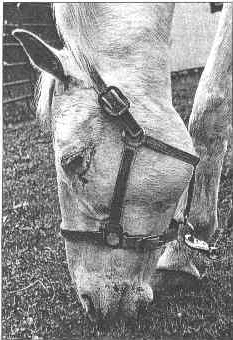
Horses' front teeth are designed for nipping off grass.
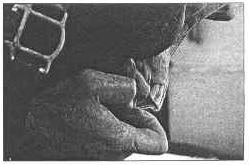
This horse's incisors are way too long. This has accentuated his overbite (the top teeth are forward of the bottom
teeth).
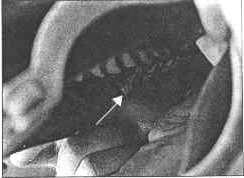
This horse's back teeth are also misaligned. His upper set of cheek teeth are too far forward relative to the lower
set. This poor conformation and
the too-long incisors have contributed to uneven wear of the back teeth. The arrow marks a large hook or "beak"
on the first premolar.
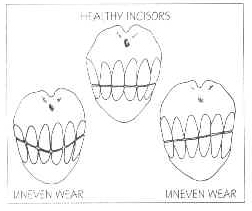
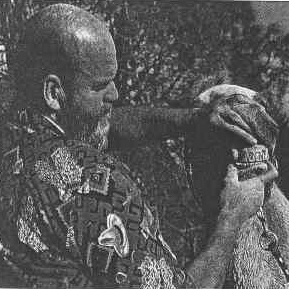
As Dr. Mitch Benson pushes Dancer's jaw to the right, her front teeth stay closed. This tells him her front teeth
are too long, preventing the molars from making contact in the back of the mouth.
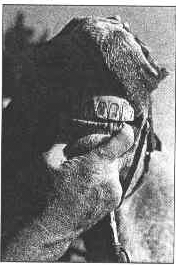
After full mouth dentistry (see photos page 7), Dancer's front teeth open when her jaw is moved. This action shows
that she now has proper molar contact.
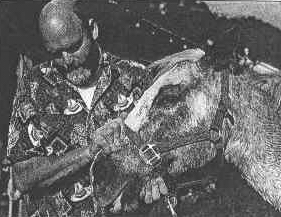
In order to listen for the molars grinding properly, Dr. Benson places Dancer's front teeth together, stabilizes
her skull/upper jaw with his right hand and uses his left hand to move her lower jaw sideways. Try this on your
own or enlist a friend to help. One person moves the jaw as pictured while the other places their ear next to the
horse's cheek to listen for grinding. 
|


